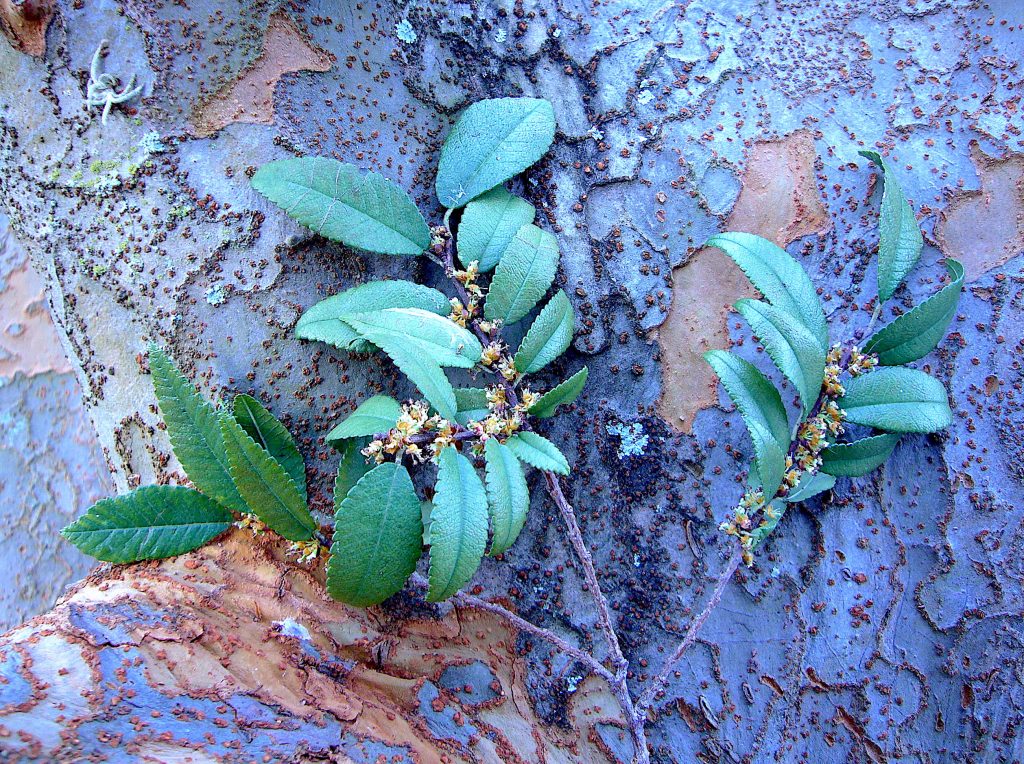
Chinese Elm has edible leaves, seeds and inner bark. Photo by Green Deane
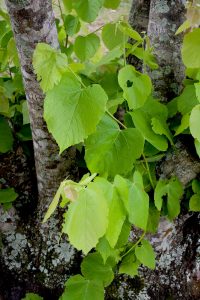
Basswood’s inner bark and leave are also edible. Photo by Green Deane
We don’t have the opportunity to often use the word “windfall” in modern society as it was originally coined: A benefit caused by the wind literally knocking something down. Roman armies gathered wind-felled wood for their camp fires. From a foraging point of view there are a couple of tree species worth investigating if they are blown over. One is pines. It’s an opportunity to harvest cambium and or nearly ripe cones for their seeds. It’s fairly easy to strip “fillets” off downed limbs or young trunks. And one does not have to climb the tree for the cones. A second tree worth investigating is the Chinese Elm. It’s used in landscaping intensely. During the Great Depression of the 1930’s the species was planted by the millions and is perhaps are the most intentionally planted tree outside of the lumber industry. A windfall of this species brings not only young leaves and samaras within reach but also provides easy access to the tree’s cambium which is edible. Every tree’s cambium grows differently and is the “living” part of the tree. It grows in two directions at once, in and out. The inner cambium become the wood of the tree. The outer cambium becomes the bark of the tree. This gives each tree it’s distinction wood and bark. And on the Chinese Elm (all Ulmus actually) and the pine (all Pinus) the cambium is edible.
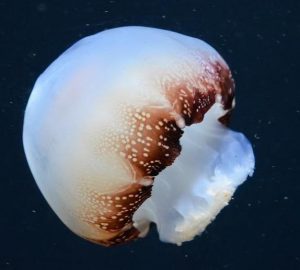
Stomolophus meleagris, one of our edible jellyfish.
I will be on the beach later this week for a combination festival, birthday, and Veterans Day remembrance. One often seeds a jellyfish or two and many are edible including some that are found in local waters. I had a friend from Taiwan who never ordered from the menu at Chinese restaurants. It was always off-the-menu and then after much discussion with the waiter and sometimes even the chef. One of those chats produced a dish of jellyfish. I was hooked. It was very tasty and jellyfish can be caught while casting for other fish. (I like castnetting and will admit to being a castnet junkie.) While a substantial food I’m not sure jellyfish would qualify as a staple because catching them by hand is by chance (which does increase however when in season.) They are also mostly water and need to be dessicated immediately, not a small process. It all depends on how hungry you are and how many of them you have. You should get them live out of the water, not dead on the beach. To read about jellyfish go here.
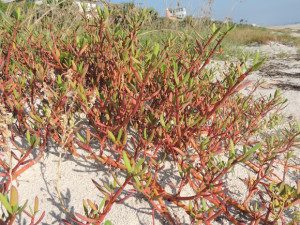
When Sea Purslane sequesters salt it turns pink. Photo by Green Deane
Also noticeable seaside are Sea Oats, edible but protected because they help secure the dunes. (You might want to consider as an alternative Wood Oats which are found inland and not protected.) Also hard to ignore is sea purslane. This time of year its stems can be quite red. Technically it’s not a seasonal plant because it grows all year but it does favor the spring putting on a lot of new shoots. By the time autumn falls the plant has been isolating salt from the water which turns its stems red. Thus one uses green stems as greens (boiled, roasted or in a fish or the like you are cooking) and the red stems for salt or seasoning. The older stems also get a woody core so one usually does not eat them. Young greens can be tossed right on the grill and wilted for a wonderful flavor. Sea purslane will also happily grow in your non-salty garden. It competes successfully in salty areas but does not have to be in salty ground. If you grow it at home it is not salty. To read more about sea purslane go here.
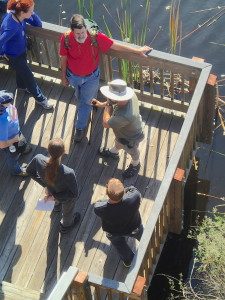
Foraging Classes are held rain or shine.
Florida is a large state and I range four hundred miles of it this weekend, from Gainesville Saturday to West Palm Beach Sunday.
Saturday, November 10th, Boulware Springs Park, 3420 SE 15th St., Gainesville, FL 32641. 9 a.m. to noon. Meet by the pump house.
Sunday, November 11th, Dreher Park, 1200 Southern Blvd., West Palm Beach, 33405, West Palm Beach, FL 32641. 9 a.m. to noon. Meet just north of the science center.
Saturday, November 17th, Florida State College, south campus, 11901 Beach Blvd., Jacksonville, 32246. 9 a.m. to noon. We will meet at building “D” next to the administration parking lot.
Sunday, November 18th, Haulover Canal, Merritt Island National Refuge, north of the Kennedy Space Center. 9 a.m. to noon. We meet at the northwest end of the canal where the kayaks launch.
Saturday, November 24th Blanchard Park, 10501 Jay Blanchard Trail, Orlando. 9 a.m. to noon. Meet next to the tennis courts by the YMCA building.
Sunday, November 25th, Red Bug Slough Preserve, 5200 Beneva Road, Sarasota, FL, 34233. 9 a.m. to noon. Meet at the entrance of the park.
You can learn more about the foraging classes here.
 There are a couple of things to mention. First I am looking for a new class location in Pinellas County preferably on private land or a business that is involved with plants. Physically it should be a few acres and have a variety of environments such as grass/lawn, ponds, trees… kind of like most old city parks. Those features ensure enough plant variety for a three-hour foraging class. Totally “natural” areas actually offer less foraging variety. While drinking water is not necessary adequate bathrooms and parking are. I would have classes there every six to eight weeks. If you know of such a situation please email me. And…. Some of you may not know I downsided my life a few years ago and moved into a small rental. My lease is up and I’ve been pondering moving to somewhere in southwest, Florida, Venice south would be nice but also Sarasota/Bradenton. A southern move would also open up the potential for classes in Naples and Miami. It’s just me and two cats and we are extremely quite. My current rental is one bath, one bedroom, one office/storage room. In town, out in the country, mother-in-law cottage is fine as is a duplex if the other side is quiet. I’m usually gone on weekend and can trade out landscaping and house sitting. I do spend at least three days a week at L.A. Fitness so a gym within driving distance would be nice. If you know of a possibility please let me know.
There are a couple of things to mention. First I am looking for a new class location in Pinellas County preferably on private land or a business that is involved with plants. Physically it should be a few acres and have a variety of environments such as grass/lawn, ponds, trees… kind of like most old city parks. Those features ensure enough plant variety for a three-hour foraging class. Totally “natural” areas actually offer less foraging variety. While drinking water is not necessary adequate bathrooms and parking are. I would have classes there every six to eight weeks. If you know of such a situation please email me. And…. Some of you may not know I downsided my life a few years ago and moved into a small rental. My lease is up and I’ve been pondering moving to somewhere in southwest, Florida, Venice south would be nice but also Sarasota/Bradenton. A southern move would also open up the potential for classes in Naples and Miami. It’s just me and two cats and we are extremely quite. My current rental is one bath, one bedroom, one office/storage room. In town, out in the country, mother-in-law cottage is fine as is a duplex if the other side is quiet. I’m usually gone on weekend and can trade out landscaping and house sitting. I do spend at least three days a week at L.A. Fitness so a gym within driving distance would be nice. If you know of a possibility please let me know.
 Donations to upgrade EatTheWeeds.com and fund a book have gone well and made it past the half way mark. Thank you to all who have contributed to either via the Go Fund Me link, the PayPal donation link or by writing to Green Deane POB 941793 Maitland FL, 32794. There are many needs left such as expanding the foraging teacher page and the page on monotypic edibles. Several functions were also lost when we transitioned to the new website. There’s always something and such things get more complex and expensive every year.
Donations to upgrade EatTheWeeds.com and fund a book have gone well and made it past the half way mark. Thank you to all who have contributed to either via the Go Fund Me link, the PayPal donation link or by writing to Green Deane POB 941793 Maitland FL, 32794. There are many needs left such as expanding the foraging teacher page and the page on monotypic edibles. Several functions were also lost when we transitioned to the new website. There’s always something and such things get more complex and expensive every year.
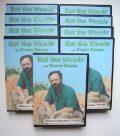
Green Deane DVD set of 135 videos
All of Green Deane’s videos are available for free on You Tube. They do have ads on them so every time you watch a Green Deane video I get a quarter of one cent. Four views, one cent. Not exactly a large money-maker but it helps pays for this newsletter. If you want to see the videos without ads and some in slightly better quality you can order the DVD set. It is nine DVDs with 15 videos on each for a total of 135 videos. Many people want their own copy of the videos or they have a slow service and its easier to order then to watch them on-line. The DVDs make a good gift for that forager you know especially on long, cold winter months. Individual DVDs can also be ordered or you can pick and choose. You can order them by clicking on the button on the top right hand side of this page (if your window is open wide enough.) Or you can go here.

Green Deane Forum
Want to identify a plant? Need to identify a plant? Looking for a foraging reference? Maybe you have a UFO, an Unidentified Flowering Object, you want identified. On the Green Deane Forum we — including Green Deane — chat about foraging all year. And it’s not just about warm-weather plants or just North American flora. Many nations share common weeds so there’s a lot to talk about. There’s also more than weeds. The reference section has information for foraging around the world. There are articles on food preservation, and forgotten skills from making bows to fermenting food. Recent topics include: I Finally Found Wapato, Looks like Corn, Weed With Pod At Top, A Mile Walk In The Woods, Chicken of the Woods?, Elderberry Fungus, Spurge Nettle 2018, Does Anybody Know This Berry, and Five-Minute “English” Muffin with Beautyberries. You can join the forum by clicking on the button in the menu line.
This is weekly issue 329.
If you would like to donate to Eat The Weeds please click here. Or you can use my Go Fund Me link, or by writing to Green Deane POB 941793 Maitland FL, 32794


Enjoy your Birthday on the beach!